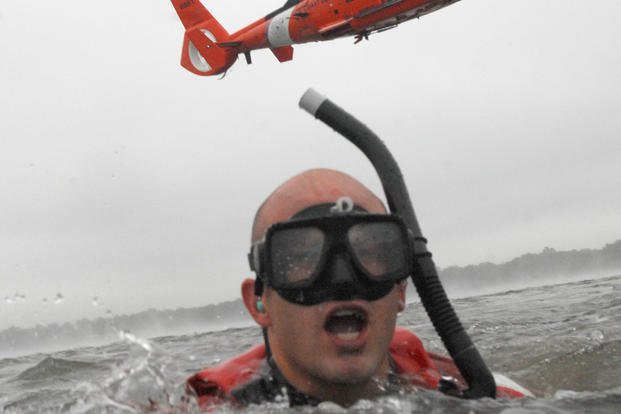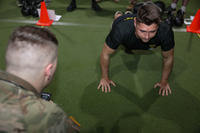The helicopter rescue swimmers of the Coast Guard, Navy and Air Force saved thousands of people stuck in the flooded areas of New Orleans when the levees broke. If it were not for these brave pilots and search-and-rescue (SAR) swimmers, several thousand people would have died.
This article is a tribute to the sailors and airmen of the Navy, Coast Guard and Air Force who risked their lives to save others by hanging from a helicopter and plucking hurricane victims from certain death. If you have thought about becoming a Coast Guard helicopter rescue or SAR swimmer, be prepared because it is tough. The training is some of the most grueling in our military.
When you arrive at Navy SAR or USCG Rescue Swimmer School, you will be placed in a stressful environment and expected to excel in military education, close-quarter living, teamwork and physical fitness tests (PFT).
According to the SAR swimmer course syllabus, rescue swimmers must have flexibility, strength, endurance and function for 30 minutes in heavy seas.
However, the operations manual includes lessons in eight water deployment procedures; 11 ways to approach, carry and release a survivor; seven ways to release equipment for Navy and Air Force flyers; and ways to detangle the services' different parachutes and backpacks. You have to think and perform challenging tasks while submerged, holding your breath and getting tossed around by 10- to 20-foot waves.
Rescue swimmers also must have the skills to provide basic pre-hospital life support for rescued individuals. And as part of their training, candidates must complete an emergency medical training course. This is not an ordinary EMT; the training you are seeking will challenge you to your core. In fact, SAR Swimmer School boasts more than a 50% attrition rate, so it is crucial you go to the training scoring high in your PFT. More importantly, be confident -- but not cocky -- in the water. You must have a deep respect for the power of the sea, but know that your training will help save your life and the lives of the ocean's victims.
The required monthly physical training test includes push-ups, sit-ups, pull-ups, chin-ups, a 12-minute crawl swim (500-yard minimum), 25-yard underwater swim and a 200-yard buddy tow. I recommend the following scores to succeed with the training course:
- Push-ups: 100 in two minutes
- Sit-ups: 100 in two minutes
- Pull-ups: 15-20
- 12-minute swim: Swim 500-750 yards
- 1.5-mile run: Sub-nine minutes
- 25-yard underwater swim: Complete
- 200-yard buddy tow: Complete
If you are considering this profession, take an ocean lifeguard course with the Red Cross to see whether you have what it takes. You will learn how to perform the crawl stroke, underwater swim and buddy tow properly with this preparatory course.
Learn About Special Operations Forces
I recently trained some sailors who graduated from SAR school, and I created the Coast Guard Helicopter Rescue Swimmer School for them before their training. They used the program that can be found at the Military.com Fitness eBook Store and had outstanding results.
More swimming articles:
- Popular Swimming Pool Workouts
- Rescue Swimmer Fitness Standards
- Summer Swimming Workouts
- Swimming with Fins
- Swimming Without Water
- Video: The Combat Swim
- The Combat Swim
- Passing Military Swimming Tests
Stew Smith is a former Navy SEAL and fitness author certified as a Strength and Conditioning Specialist (CSCS) with the National Strength and Conditioning Association. Visit his Fitness eBook store if you're looking to start a workout program to create a healthy lifestyle. Send your fitness questions to stew@stewsmith.com.
Want to Learn More About Military Life?
Whether you're thinking of joining the military, looking for fitness and basic training tips, or keeping up with military life and benefits, Military.com has you covered. Subscribe to Military.com to have military news, updates and resources delivered directly to your inbox.



















